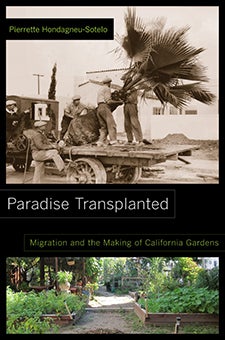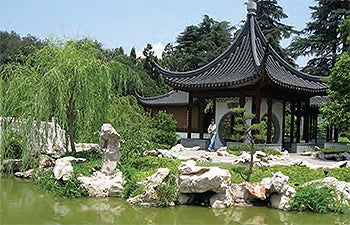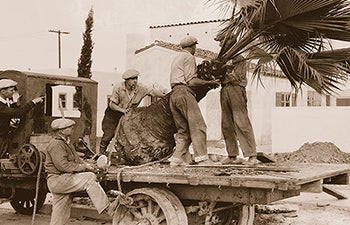Paradise Transplanted
Tomatoes, radishes, chilies and corn flourish alongside avocado, mango and papaya trees in an inner-city Los Angeles community garden. This is where some of the city’s most marginalized newcomers — poor, indigenous, undocumented migrants from Southern Mexico and Central America — gather to grow food from their homeland.
Employed mainly as nannies, housecleaners and restaurant workers, they come to the garden to pick vegetables and fruits to feed their families. But they also come to relieve homesickness by recreating a landscape that offers the familiar sights, tastes and scents of their distant home countries.

Pierrette Hondagneu-Sotelo interviewed more than 100 people including suburban homeowners, paid Mexican immigrant gardeners, professionals at the most elite botanical garden on the West Coast and immigrant community gardeners for her book. Image courtesy of Pierrette Hondagneu-Sotelo.
“Gardens offer compensation for lost worlds, bringing moments of pleasure, tranquility, and beauty and articulating future possibilities,” said Pierrette Hondagneu-Sotelo, professor of sociology and associate director of the Center for the Study of Immigrant Integration at USC Dornsife. “But these are not just gardens of nostalgia but also places where people try to problem-solve by sharing information. The gardens are like a North Star, a way to orient oneself in the new society.”
In her new book, Paradise Transplanted: Migration and the Making of California Gardens (University of California Press, 2014), Hondagneu-Sotelo draws on historical archival research, ethnography and more than 100 interviews with a wide range of people including suburban homeowners, paid Mexican immigrant gardeners, professionals at the most elite botanical garden in the West and immigrant community gardeners in the poorest neighborhoods of inner-city L.A. These various perspectives provide insights into the ways that diverse global migrations and garden landscapes shape our society.
The book tackles issues that are close to Hondagneu-Sotelo’s heart.

The new Suzhou-style garden, Lin Fang Yuan, at The Huntington Botanical Gardens in San Marino, California, was created thanks to donations from wealthy Chinese and Taiwanese immigrants. Photo by Pierrette Hondagneu-Sotelo.
A self-confessed garden-obsessive who loves nothing more than visiting gardens, Hondagneu-Sotelo is proud of her own award-winning backyard in South Pasadena, California, which has twice been featured on a local garden tour.
Herself the daughter of immigrants — both her parents grew up on small family farms; her father, later himself a gardener, in the French Pyrenees and her mother in Chile — Hondagneu-Sotelo’s personal connection with California migrants has inspired much of her work as a sociologist.
“The more I looked around me, whether at home or at work, I realized that immigrants and gardens are inextricably entwined in a symbiotic relationship here,” she said. “While the image of Southern California gardens is well known — you could ask anyone in the world to imagine one, and some image of lawn, palm trees and maybe a pool comes immediately to mind — the story of how migration is bound up with creating that ideal and the material reality of gardens, is one that hadn’t yet been told, and was one I very much wanted to tell.”
The plants, the people and the water needed to create California’s lush and exotic gardens come from other places, other lands. Even the palm trees that are so symbolic of Southern California, were mostly imported from elsewhere. Out of hundreds of species of palm trees growing in California, only one, Washingtonia filifera, is native to the state.

The majority of California’s iconic palm trees were originally brought from other places, many from other lands. Only one species, Washingtonia filifera, is native to the region. Photo courtesy of Pierrette Hondagneu-Sotelo.
“Social inequality and power exemplified by successive waves of conquests, colonization, property disputes, land development and labor exploitation, together with the newcomers’ desire for fantasy, beauty and enchantment, have etched the garden landscape,” Hondagneu-Sotelo wrote.
She argues that our engagements with gardens are shaped by social class and our access to money, land, time and labor.
That labor, she notes, is largely invisible.
“Open up any garden magazine and you’ll see gorgeous art photography of these beautiful, perfectly manicured Californian garden landscapes. The labor, however, is never featured,” she said. “None of these beautiful residential gardens would be maintained without immigrant gardeners, the majority of them Latino men.”
In her book, Hondagneu-Sotelo discusses ways in which gardens embody both pleasure and power. Private residential gardens may be used in a symbolic display of power and wealth, and for pleasurable moments of relaxation. But, she points out, the relationships that go into creating those gardens also literally embody the dynamics of power that exist between the wealthy homeowner and the often impoverished immigrant workers employed to create and maintain them.

Many Mexican immigrant gardeners approach their work with pride and dignity. Without their often invisible labor, California’s perfectly maintained gardens would not exist. Photo by Nathan Solis.
“That dualism is key in all gardens,” she said. “We think of gardens as pleasurable, tranquil havens, we carry images in our minds of Eden and Shangri-La. However, I also wanted to discuss the fact that making one person’s paradise may involve destroying someone else’s home and may also lead to exclusion, exploitation and conflict.”
Hondagneu-Sotelo also examines questions of power, status and beauty at The Huntington Botanical Garden, the leading botanical garden on the West Coast which recently opened a Suzhou-style Chinese garden, thanks to donations from wealthy Taiwanese and Chinese immigrants from the transnational business class.
“In the book I detail that process and ask what are its implications, raising the question of whose culture is considered worthy of being displayed in an institution like The Huntington. Mexicans are by far the largest immigrant group in the state, but they do not have the power, the influence or the money to be included at that level.”
Hondagneu-Sotelo proposes rethinking our gardening practices in ways that would respect social justice, while being both environmentally and culturally sustainable. She suggests creating more urban community and public gardens, bidding farewell to the hitherto cherished Victorian-style lawn, and moving toward more drought-resistant edibles and ornamentals.
“Some people dismiss Southern California as a dystopian, apocalyptic land of plastic and concrete built on false promises and hyperbole. Yes, some of this is true. But I choose to articulate a narrative that emphasizes the talents and radical heterogeneity that multiple migrations have spawned here, and to celebrate the beauty and potential of nature, and the promise of social change that may foster a more ecological and democratic Eden on Earth,” she wrote in the preface. “I don’t think it’s too late.”